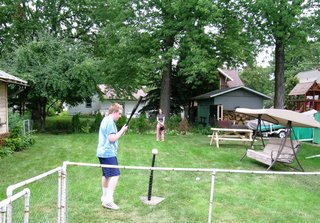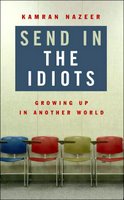>We ventured out late in the day, after supper, figuring that the wild and crazy folks who stayed up on night for the doorbusters would be home and in bed. We were right; traffic wasn’t bad at all, and the stores were quite uncrowded. Store staff looked worn out, though.
We stopped at Goodwill first. Daughter wanted an “ugly sweater” to wear to a theme party later this month. We laughed at each other because I actually wear seasonal sweaters to work! Elementary teachers can get away with that. While she dragged several options off the racks and tried on her favorites, I actually found something like new for Amigo and a seasonal sweater (Croft and Barrow, it’s okay!) for me. We bought two reusable cloth shopping bags so we could say “We don’t need a bag” at the checkout, and headed to the next store. Pictures will have to come later.
Steve and Barry’s was next on our list. We’re so sad that this company is going out of business. Good casual clothes, Sarah Jessica Parker’s Bitten line, and really, really reasonable prices were not enough to keep S & B’s afloat. La Petite and I both mourn its liquidation, so we grieved by shopping there one last time. Bitten runs small (perfect for La Petite, not so for me), and it seemed that my doppelganger in philosophy and size must have been there earlier in the day. My favorite shirt and jacket didn’t come in XL, and the L was too tight across the, er, chest. I may try again; the manager said there was more stock in the back. Daughter’s measurement nearly mimic SJP’s, so she went to town picking out classic pieces.
I picked up baby gifts there for the second time in a few months. I resisted the adorable baby blankets and bibs with bunny appliques and picked up the cute, cute little onesies instead.
I had an odd feeling standing in the men’s department looking at the pullover hoodies sporting car company logos. Ford. Chevy. GMC. Are these sweatshirts not selling because people are afraid they’ll be wearing anachronisms on their chests? Shouldn’t people buy these because they’re timeless classics, no matter how the car companies restructure? Will a bailout help the Detroit Lions become more competitive, too? And why was I having such philosophical thoughts in the middle of a going-out-of-business sale?
The S&B store was selling their hangers, too: nice wood ones. Again, I may go back and buy a few. If they sell their shopping bags as well, the nylon mesh ones, I’ll buy a couple. They’d be good travel bags, especially for swimsuits. They might also make good shopping bags for large purchases — like the ones we might make in the next few weeks.
Our last stop was Walgreens for a few basic meds in my cabinet. My favorite cough drops (Ricola green tea/echinacea), fake pseudophedrine (the kind no meth dealer would desire), and a couple of toiletries for La Petite and Amigo. Once again we used our own bag, the Chico Bag in my purse.
To summarize:
3 stores
Successful purchases at all three
Gift purchases at two (no, I’m not telling, my family reads this blog!)
Good deals at first two, reasonable prices as always at third
Only two plastic shopping bags, used our own at the other places.
Funny philosophical thoughts at first store (pictures of the Ugly Seasonal Sweaters will have to come later)
Strange philosophical thoughts at second store
No philosophical thoughts at all at third store
All in all, a good evening shopping. I didn’t have to camp out overnight or wake up in the wee hours, either.





